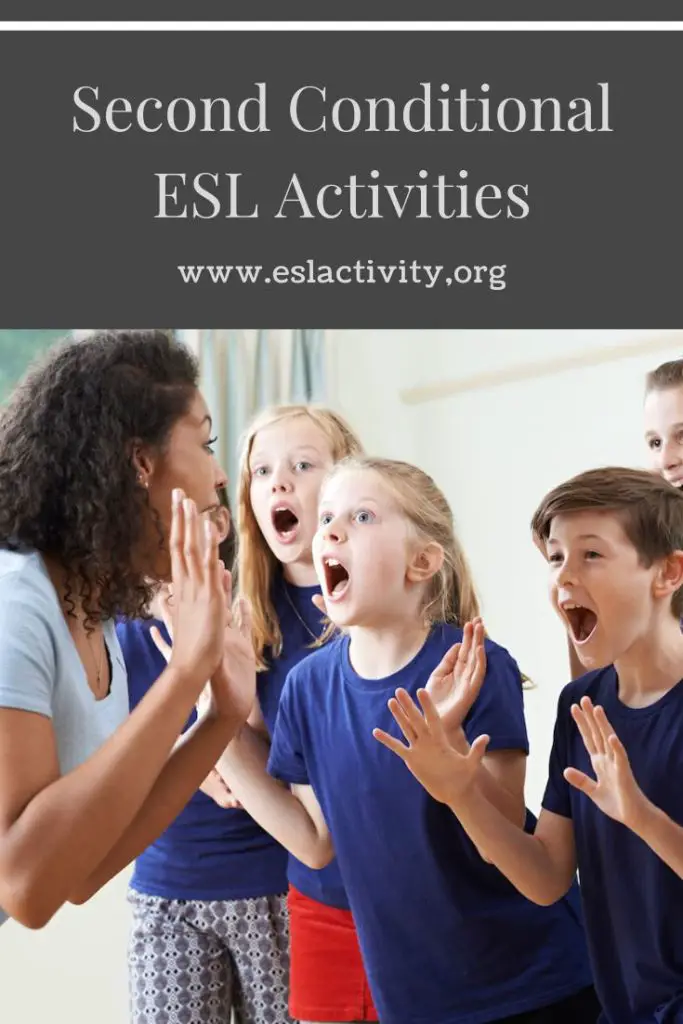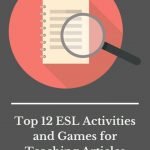If you’re looking for everything teaching the second conditional, you’re in the right place. We have 2nd conditional games, activities, lesson plans, and worksheets. You can also see some second conditional sentences and questions. Keep on reading!

2nd conditional activities and games
What is the Second Conditional?
In case you need a small review about what the second conditional is, it’s used to imagine a present or future situation that is impossible or unlikely.
For example, “If I won the lottery, I’d buy a big house.” Winning the lottery is very unlikely to happen!
The structure can change slightly, depending on the situation but is usually: if + past simple —> would + infinitive.
Second Conditional ESL Activities and Games
Let’s get into the best ESL 2nd conditional games to use in class with all ages.
#1: Concentration
A nice option for a fun game related to this grammar point is concentration. It’s a serious memory game.
Make cards, each with one half of a corresponding 2nd conditional sentence. Students play in small groups and have to match the cards to see who can get the most points. Check it out:
#2: Is That Sentence Correct?
This is a nice activity when the grammar in terms of conjugations and word order is a little bit tricky. Students have to decide if the statement or question is incorrect. If correct, they leave it. If incorrect, they can change it to make it correct.
To level up the difficulty, they can answer the question or write the corresponding statement to a question. Find out more:
#3: Vocabulary Auction
#4: Man/Woman on the Street Interview Activity
This activity takes something usual (talking with a partner) and makes it way more interesting and fun. Students can cone up with some questions using the target vocabulary and then get to interviewing. Find out more about it:
Man/Woman on the Street Interview.
#5: Dictogloss
This is a nice activity for higher-level students. Find, or write a passage with some examples of the target grammar.
Put students into pairs and read it out at a fast pace for the level of the students. They can take notes and then compare what they have with a partner. The goal is to recreate what they just heard. Read it again and students do the same. Finally, they can compare what they have with the original version. Check it out:
#6: Fill in the Blank Games
The grammar of these kinds of sentences can be a wee bit tricky. That’s why it’s ideal to use some fill in the blank activities and games until students learn the ropes a little bit. Take a look at some of my top options:
#7: Plan an ESL Speaking Lesson for the 2nd Conditional
#8: Survey
Just ask my students and they’ll tell you how much I love surveys! They work perfectly for the 2nd conditional. Find out howe easy it is to make your own here:
#9: Journalling
There are lots of nice 2nd conditional questions that students could write about in a journal entry. For example, what they’d do if they won the lottery, or what they’d change about themselves. Check out this activity:
#10: Mixed Up Sentences
This is a nice option when there is some tricky things in terms of word order when making a grammatically correct sentence. Mix up some sentences and students have to race to unscramble them. Check it out:
#11: Flyswatter
Write down some clauses from the second half of a 2nd conditional sentence on the board. Then, say the first half of the sentence and students have to race to be the first person to slap the correct one from the whiteboard.
It’s the ultimate activity for creating some fun and excitement in the class. Learn more about it:
#12: Running Dictation
#13: Finish the Sentence
Give students some hypothetical sentence starters using the target grammar and have them finish the sentence. This makes a really nice homework assignment, or for an exam.
#14: Use a Reading Lesson Plan
It’s easy to make your own reading lesson to target just about any grammar point, including this one! Find a passage with plenty of examples of the second conditional, and then design an entire lesson around it. It really isn’t that difficult! Check out all the steps right here:
How to Plan an ESL Reading Lesson.
#15: Solve a Problem
Think about some hypothetical situations are unlikely to happen. For example, you’re on a deserted island with cans of food but no can opener. Then, students have to work together in groups to come up with a solution. The class can vote on their favourite one.
#16: If I Were President…
Have students make a short presentation about what they’d do if they were the president of your country. The class can vote on who would do the best job.
#17: Agony Aunt
Have students think about a small problem and then get some advice from their classmates. People can start off the advice with, “If I were you, I would . . .”
#18: What Would You Do?
Present various hypothetical situations to students and ask them to discuss what they would do if those situations occurred. For example, “What would you do if you won a million dollars?” This activity promotes critical thinking and encourages students to use the second conditional to express their responses.
#19: Picture Prompts
Show students a series of pictures depicting different scenarios. Ask them to create sentences or short stories using the second conditional based on the images. This activity helps develop storytelling skills and reinforces the use of the second conditional in context.
#20: Problem-Solving Scenarios
Provide students with problem-solving situations, and ask them to come up with solutions using the second conditional. For example, “If you missed the bus, what would you do?” This activity encourages creative thinking and promotes language production.
#21: If I Had a Time Machine” Writing
Ask students to imagine having a time machine and write a paragraph or short essay about where they would go and what they would do if they had the opportunity. This activity allows students to practice using the second conditional in a written format.
#22: Conditional Chain Game
Have students sit in a circle. Start with a conditional statement using the second conditional, such as “If I won the lottery, I would travel the world.” The next student must build upon that sentence, using the second conditional, and so on. This game fosters fluency and creativity in constructing conditional sentences.
#23: Song Lyrics Analysis
Choose a song that contains examples of the second conditional. Provide the lyrics with the conditional sentences removed and ask students to fill in the missing parts. Then, play the song and have them listen and sing along while paying attention to the correct conditional usage.
Second Conditional Worksheets
If you’re a teacher, then you already know how much time it can save to use materials that others have created. Here are some fo the top picks for 2nd conditional worksheets.
ESL 2nd Conditional Lesson Plans
Have a look at some of my favourite options for 2nd conditional ESL lessons for all ages.
Second Conditional Questions
Here are some conversation questions for the second conditional.
- If you could change once thing about yourself, what would you chance?
- If you changed your name, what would you choose?
- If you could go back in time, what era would you go to?
- If you could be invisible for a day, what would you do?
Second Conditional Sentences
Here are some example sentences using the 2nd conditional.
- If I won the lottery, I’d buy a Ferrari.
- I’d go out way more often if I lived in a bigger city.
- If I were rich, I’d travel the world.
- She would probably pass her driving test, if she practiced.
- If I had his phone number, I’d call him to ask him out on a date.
If you’re looking for more conditionals, have a look here: Zero Conditional Activities.

ESL 2nd conditional
FAQs
There are a number of questions that people have about teaching conditionals. Here are the answers to some of the most common ones.
How do you teach the second conditional?
To teach the second conditional, first set the context. For example, winning the lottery. Then, show students the forms related to this. Do some controlled and then some freer practice.
How do you explain the second conditional?
To explain the second conditional, you can tell students that it deals with a present or future situation that is very unlikely to ever happen. For example, meeting a famous person randomly on the street.
What’s the difference between the first and second conditional?
The main difference between the first conditional and the second conditional is how likely the thing is to happen. If it’s likely, use the 1st conditional. If unlikely, use the 2nd.
What’s the difference between the second and the third conditional?
The second conditional deals with present or future things that are unlikely to happen. The third conditional refers to past consequences.
More Ideas for Teaching English Grammar
- Amazon Kindle Edition
- Bolen, Jackie (Author)
- English (Publication Language)
- 112 Pages - 10/24/2019 (Publication Date)
The key to better English classes is a wide variety of engaging and interactive games and activities. This book will help you get there in style: 39 No-Prep, Low-Prep ESL Grammar Activities, and Games.
Pick up a copy of the book today and get ready for better English classes tomorrow!
Tips for Teaching the Second Conditional
Teaching conditionals to ESL students can be challenging, but with the right approach, it can become engaging and effective. Here are some tips to help you teach conditionals.
Start with Real-Life Examples
Begin by introducing conditionals using real-life situations that students can relate to. Use examples that illustrate the cause-and-effect relationship, such as “If it rains, we will stay indoors” or “If you study hard, you will pass the exam.” This helps students understand the concept in a practical context.
Use Visuals and Realia
Utilize visual aids, real objects, or pictures to support the understanding of conditionals. Use timelines or flowcharts to visually represent the structure of different conditional forms. Visual representations can make abstract concepts more concrete and easier to comprehend.
Present One Conditional Form at a Time
Teach each conditional form (zero, first, second, third) separately, focusing on its structure and usage. Introduce the specific verb tenses, such as present simple, will + base verb, or past simple, associated with each conditional form.
Provide Clear Explanations
Offer clear explanations of the rules and structures of each conditional form. Break down the components, including the if-clause (condition) and the result clause (consequence). Highlight the differences between the forms and when to use them.
Practice with Contextualized Activities
Engage students in contextualized activities that require the use of conditionals. Create situations or scenarios where students have to apply the correct conditional form. This can include role-plays, problem-solving tasks, or discussions about hypothetical situations.
Use Authentic Materials
Incorporate authentic materials, such as songs, videos, news articles, or short stories, that contain examples of conditionals. This exposes students to the language used in real contexts and helps reinforce their understanding of conditionals.
Provide Structured Practice
Offer structured exercises and worksheets for students to practice forming and using conditionals. Include a variety of practice activities, such as gap-filling exercises, sentence transformations, or completing dialogue exercises. Gradually increase the complexity of the exercises as students become more comfortable with the conditional forms.
Offer Error Correction and Feedback
Monitor students’ use of conditionals and provide corrective feedback. Address common errors and misconceptions to help students improve their accuracy. Encourage peer review and self-correction to foster independent learning.
Encourage Speaking and Writing Activities
Provide ample opportunities for students to practice using conditionals in speaking and writing tasks. Assign discussion topics or writing prompts that require the use of conditionals to express opinions, make predictions, or discuss hypothetical situations.
Review and Reinforce
Regularly review previously taught conditional forms to reinforce students’ understanding. Incorporate quick review activities, quizzes, or games to keep the concepts fresh in their minds.
Teaching the 2nd Conditional: Join the Conversation
Do you have any tips or tricks for teaching conditionals? Leave a comment and let us know. We’d love to hear from you.
Last update on 2022-07-17 / Affiliate links / Images from Amazon Product Advertising API





